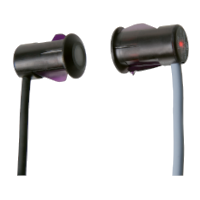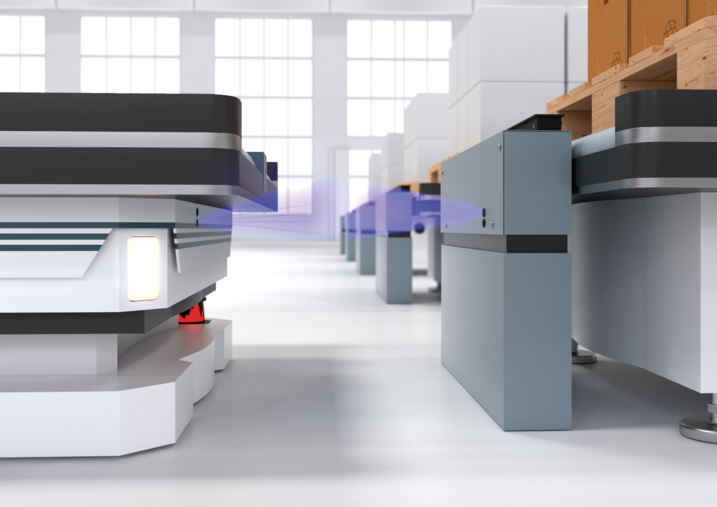AMR'leri Kullanarak Malzemeleri Aktarım İstasyonlarına Güvenilir Bir Şekilde Aktarma
Güçlü Sinyal İletimi için Geniş Açılma Açısına Sahip Karşılıklı Fotoelektrik Sensör

Uygulama
Otonom mobil robotlar (AMR'ler), üretim ve depo lojistiği kapsamında malları bir konumdan diğerine taşır. Aktarım istasyonlarında mallar otomatik olarak AMR'ye yüklenir ve boşaltılır. Genellikle birkaç istasyon yan yana bulunur. İlk olarak mal taşıyıcının sorunsuz ve güvenli bir şekilde aktarımını sağlamak için AMR'nin bir istasyona güvenli bir şekilde yanaşması gerekir. Aktarım sırasında yükleme ve boşaltma yönünü kontrol etmek için AMR ile aktarım istasyonu arasında basit ancak güçlü sinyal iletimi gerekir.
Hedef
Buradaki odak noktası, yükleme ve boşaltma işlemini kontrol etmek için güçlü bir sinyal iletim bağlantısı oluşturmaktır. AMR ve yükleme istasyonu arasındaki iletişim kanalını etkileyebilecek metal yapılar varsa bağlantı da güvenilir bir şekilde çalışmalıdır. Bazı durumlarda AMR'nin sinyalleri doğru yükleme istasyonuna aktardığını onaylamak da gerekebilir. Bu, AMR'nin hedef konumunu olabildiğince hızlı ve kolay bir şekilde tanımasına yardımcı olur. Vericiden gelen ışık sinyali, AMR'nin yolundan bağımsız olarak, araç doğru şekilde hizalanmasa veya rotadaki hafif tümsekler gibi faktörlerin neden olduğu titreşimler olsa bile alıcı elemana önceden ulaşmalıdır. Standart bir karşılıklı fotoelektrik sensörün ışık noktası bu görev için çok küçük olur; AMR her seferinde konumunu bulamaz. Standart bir karşılıklı fotoelektrik sensör sistemi, araç durduğu sırada hareketleri veya engebeli zeminden kaynaklanan konum değişikliklerini telafi edemez.
The Solution

BB10-P-F1/BB10-P-F2 series
The BB10-P-F1/BB10-P-F2 series of thru-beam sensors provide the ideal complete package. By using two thru-beam sensors, simple two-bit signal transmission can be established to trigger loading or unloading at the transfer station. The first sensor signals the completion of the positioning process and the second sensor triggers the loading or unloading process. The signal transmission can be made completely process-safe by using two thru-beam sensors with different transmission frequencies. This is because cross talk caused by reflections from metal parts can be prevented, even when the sensors are positioned very close together. This communication can also be used to confirm the right transfer station is being used or to find the right transfer station before precisely positioning the AMR. This is made possible by having a transmitter that uses transmission frequency 1 on the AMR, which pairs with receivers using receiver frequency 1 on the transfer stations. By simply activating the receiver of a transfer station, the right transfer station can be confirmed very easily over a long distance using a thru-beam sensor. The receiver on the unused station is simply deactivated because there is no transfer pending. The ideal size of the light spot and receiver opening angle ensures reliable detection, even if the vehicle is not optimally aligned or if there are vibrations affecting the AMR.
Technical Features
- Thru-beam sensor with sensing range of 0 m to 3 m, no dead band
- Large light spot (350 mm diameter at a distance of 3 m) and receiving angle
- Two transmission frequencies
- Infrared light to prevent interference
- Plug-in housing for easy front mounting
- High IP67 degree of protection

The Benefits
The use of two thru-beam sensors is a very space-saving and—above all—cost-effective way of solving the task. The two different transmission frequencies can also be used to advantage: First, the right station is detected using frequency 1. Switching a second pair of sensors to frequency 2 triggers the loading or unloading process. This signal is robust and not affected by interference, unlike AMR wireless communication, which can be impaired in certain areas of environments with many metal components. Regulations for radio communication or bandwidths do not apply. Using two different transmission frequencies prevents cross talk caused by light beam reflections. The devices emit infrared light that is invisible to the human eye, so there are no irritating visual effects.
At a Glance
- Large light spot and large receiving angle ensure that the transfer station is reliably detected
- Strong optical signal connection, no interference from metal components
- Two transmitter frequencies enable parallel operation with additional function
- Infrared light signal is invisible to the human eye and does not cause interference
- Easy front mounting, no bracket required









 +90 216 577 2250
+90 216 577 2250